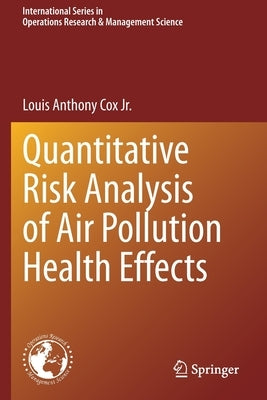Description
This book highlights quantitative risk assessment and modeling methods for assessing health risks caused by air pollution, as well as characterizing and communicating remaining uncertainties. It shows how to apply modern data science, artificial intelligence and machine learning, causal analytics, mathematical modeling, and risk analysis to better quantify human health risks caused by environmental and occupational exposures to air pollutants. The adverse health effects that are caused by air pollution, and preventable by reducing it, instead of merely being statistically associated with exposure to air pollution (and with other many conditions, from cold weather to low income) have proved to be difficult to quantify with high precision and confidence, largely because correlation is not causation. This book shows how to use recent advances in causal analytics and risk analysis to determine more accurately how reducing exposures affects human health risks.
Quantitative Risk Analysis of Air Pollution Health Effects is divided into three parts. Part I focuses mainly on quantitative simulation modelling of biological responses to exposures and resulting health risks. It considers occupational risks from asbestos and crystalline silica as examples, showing how dynamic simulation models can provide insights into more effective policies for protecting worker health. Part II examines limitations of regression models and the potential to instead apply machine learning, causal analysis, and Bayesian network learning methods for more accurate quantitative risk assessment, with applications to occupational risks from inhalation exposures. Finally, Part III examines applications to public health risks from air pollution, especially fine particulate matter (PM2.5) air pollution. The book applies freely available browser analytics software and data sets that allow readers to download data and carry out many of the analyses described, in addition to applying the techniques discussed to their own data.
http: //cox-associates.com:8899/
Author: Louis Anthony Cox Jr
Publisher: Springer
Published: 11/07/2021
Pages: 544
Binding Type: Paperback
Weight: 1.71lbs
Size: 9.21h x 6.14w x 1.14d
ISBN13: 9783030573607
ISBN10: 3030573605
BISAC Categories:
- Business & Economics | Operations Research
- Science | Environmental Science (see also Chemistry | Environmental)
About the Author
Tony Cox is Professor of Business Analytics at the University of Colorado and President of Cox Associates, a Denver-based applied research company specializing in health, safety, and environmental risk analysis; epidemiology; policy analytics; data science; artificial intelligence; and operations research. Dr. Cox is Editor-in-Chief of Risk Analysis: An International Journal. He is Area Editor for Real World Applications for the Journal of Heuristics, and is on the Editorial Board of the International Journal of Operations Research and Information Systems. He has authored and co-authored over 200 journal articles and book chapters on these fields. His most recent books are Causal Analytics for Risk Analysis (Springer, 2018), Breakthroughs in Decision Science and Risk Analysis (Wiley, 2015), Improving Risk Analysis (Springer, 2013), and the Wiley Encyclopedia of Operations Research and Management Science (Wiley, 2011), which Dr. Cox co-edited. He has over a dozen U.S. patents on applications of artificial intelligence, signal processing, statistics and operations research in telecommunications. His current research interests include computational statistical methods for causal inference in public health risk analysis, data-mining, and advanced analytics for risk management, business, and public policy applications.
This title is not returnable

